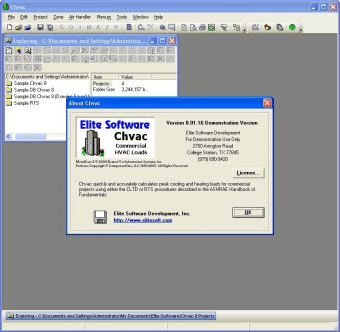

The cost of these simplifications from the theoretical best math models is accuracy. The calculations are so involved that researchers have been forced for years to create various simplified procedures that are doable by hand or within reasonable calculation time on a personal computer. The most current and best math models of this problem require significant input data and thousands of calculations in an iterative process. The physics involved in the transfer of heat and energy between buildings, occupants, and the environment is quite complex. After all, if each calculation is done with the same outside and inside temperatures, same building material types, areas and quantities of roofs, walls, glass, people, lights, equipment, etc., why should the results ever differ by more than a few percent? Many people are often alarmed to learn that various computer programs and hand calculations can differ so widely on calculation results. HVAC load calculations are most often done using computer programs, although some methods are still able to do be done by hand.


An oversized HVAC system will be inefficient, and struggle to maintain comfort conditions, particularly with humidity control during summer months.ĭifferences in HVAC Load Calculation Methods An undersized HVAC system will not be able to maintain the desired indoor temperatures. It is important to know the peak heating and cooling loads on a building so that the HVAC equipment can be adequately sized. Heat is lost through the walls, windows, roof, and through cracks and crevices where cold air seeps into the building. A winter heating load is a heat loss that is caused by loss of heat from the warm physical mass of the building to the cold air surrounding the building. And within the building itself, heat is generated by people, lights, equipment, and appliances. The sun provides all of the heat that comes in through the exterior of the building. What causes heating and cooling loads? A summer cooling load is a heat gain to the building. Again, the cooling load unit is either Btuh or watts. In the hottest time of summer, the peak cooling load is the amount of heat that must be removed in an hour to maintain a comfortable room temperature. In the metric system the equivalent unit is a watt and one watt is equal to 3.41 Btuh. imperial units system, this rate of heat transfer is in Btu’s per hour which is commonly abbreviated as Btuh.

In the coldest time of winter, the peak heating load is the amount of heat that must be added over an hour’s time to keep the space warm. Not a single quantity of heat, but an amount of heat that must be continually (at least for the worst case hour) removed or added to maintain the desired indoor temperature. So what are heating and cooling loads? As pertains to heating and cooling equipment (an HVAC System), a load is a rate of heat transfer. Such loads are measured in pounds, kips, or kilograms, depending on the units involved. All of those loads are a "weight" to be carried or supported in some way. When most people hear the word "load" they naturally think of a load of firewood they carry into the house, or a load of dirt in a dump truck, or maybe even a load held up by a beam or structural member. To help the lay person, some definitions are in order. This article is intended to be understood by both the lay person and the HVAC professional. This article discusses both commercial and residential HVAC (heating, ventilation and air conditioning) load calculation methods, and explains why results are often so different between methods. HVAC Peak Load Calculation Methods – History and Comparisons HVAC Peak Load Calculation Methods – History and Comparisonsīy Bill Smith, president of Elite Software


 0 kommentar(er)
0 kommentar(er)
